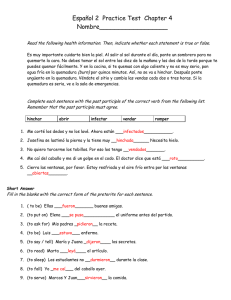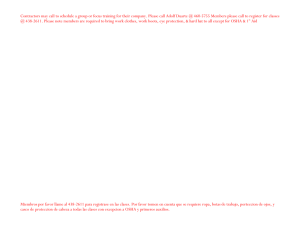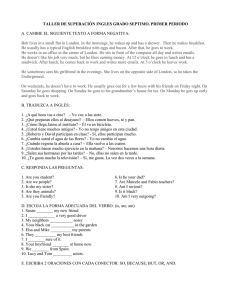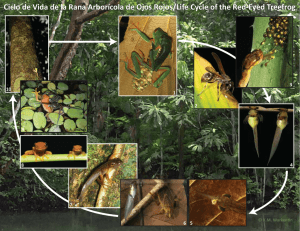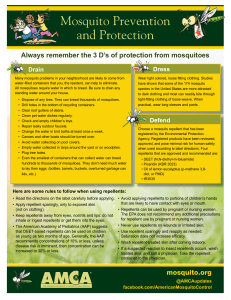control of the asian tiger mosquito in torrevieja control de mosquito
Anuncio
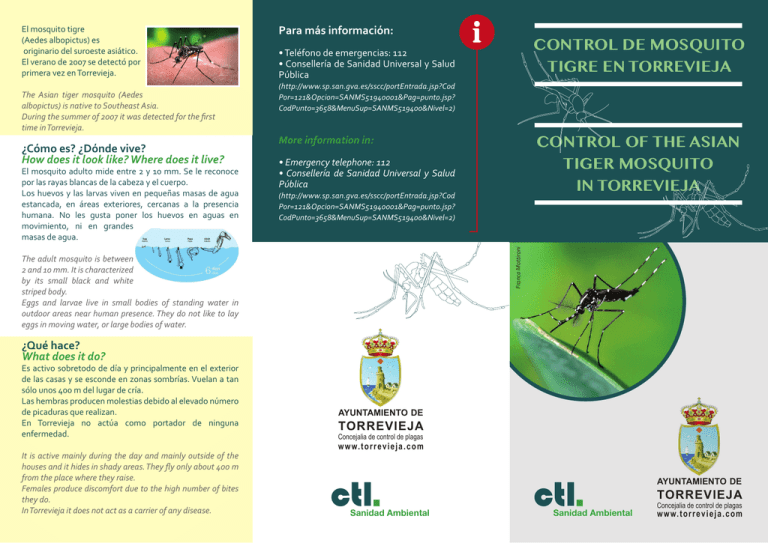
The Asian tiger mosquito (Aedes albopictus) is native to Southeast Asia. During the summer of 2007 it was detected for the first time in Torrevieja. ¿Cómo es? ¿Dónde vive? How does it look like? Where does it live? El mosquito adulto mide entre 2 y 10 mm. Se le reconoce por las rayas blancas de la cabeza y el cuerpo. Los huevos y las larvas viven en pequeñas masas de agua estancada, en áreas exteriores, cercanas a la presencia humana. No les gusta poner los huevos en aguas en movimiento, ni en grandes masas de agua. Para más información: CONTROL DE MOSQUITO TIGRE EN TORREVIEJA • Teléfono de emergencias: 112 • Consellería de Sanidad Universal y Salud Pública (http://www.sp.san.gva.es/sscc/portEntrada.jsp?Cod Por=121&Opcion=SANMS51940001&Pag=punto.jsp? CodPunto=3658&MenuSup=SANMS519400&Nivel=2) CONTROL OF THE ASIAN TIGER MOSQUITO IN TORREVIEJA More information in: • Emergency telephone: 112 • Consellería de Sanidad Universal y Salud Pública (http://www.sp.san.gva.es/sscc/portEntrada.jsp?Cod Por=121&Opcion=SANMS51940001&Pag=punto.jsp? CodPunto=3658&MenuSup=SANMS519400&Nivel=2) Franco Mottironi El mosquito tigre (Aedes albopictus) es originario del suroeste asiático. El verano de 2007 se detectó por primera vez en Torrevieja. The adult mosquito is between 2 and 10 mm. It is characterized by its small black and white striped body. Eggs and larvae live in small bodies of standing water in outdoor areas near human presence. They do not like to lay eggs in moving water, or large bodies of water. ¿Qué hace? What does it do? Es activo sobretodo de día y principalmente en el exterior de las casas y se esconde en zonas sombrías. Vuelan a tan sólo unos 400 m del lugar de cría. Las hembras producen molestias debido al elevado número de picaduras que realizan. En Torrevieja no actúa como portador de ninguna enfermedad. It is active mainly during the day and mainly outside of the houses and it hides in shady areas. They fly only about 400 m from the place where they raise. Females produce discomfort due to the high number of bites they do. In Torrevieja it does not act as a carrier of any disease. AYUNTAMIENTO DE TORREVIEJA Concejalia de control de plagas w w w. t o r r e v i e j a . c o m AYUNTAMIENTO DE TORREVIEJA Sanidad Ambiental Sanidad Ambiental Concejalia de control de plagas w w w. t o r r e v i e j a . c o m La prevención es el mejor método para el control de este mosquito. Lo más importante y efectivo es evitar la puesta de huevos y el crecimiento de sus larvas acuáticas y eliminar todos los puntos de agua donde puede crecer. La aplicación de insecticidas sobre el mosquito adulto no es un método eficaz para controlar la plaga. Prevention is the best method to control this mosquito The most important and effective is to prevent egg laying and growth of their aquatic larvae and remove all water points where they can grow. The application of insecticides on the adult stage of mosquito is not an effective method to control the pest. Por eso es necesario evitar las acumulaciones de agua en casa: It is necessary to avoid accumulation of water at home: • Vaciar dos veces por semana los recipientes del exterior que puedan acumular agua: juguetes, ceniceros, cubos, platos bajo macetas, bebederos de animales domésticos, piscinas de plástico, etc. • Empty outside containers that can collect water, such as toys, ashtrays, buckets, waterer under flower pots, pet dishes, plastic pools, etc. twice a week. • Vaciar dos veces por semana o tapar con tela mosquitera espesa los lavaderos y las balsas pequeñas. • Empty or cover with thick mosquito net laundry rooms and small ponds twice a week. • Evitar acumulaciones de agua en zonas de drenaje o canales de desagüe. • Avoid standing water in drainage areas or drainage channels. • Evitar los agujeros y las depresiones de tierra donde se pueda acumular agua y tapar los agujeros de los troncos de árboles llenándolos de arena. • Avoid holes and ground depressions where water can be accumulated and plug the holes in the trunks of trees filling them with sand or fine gravel. Cómo curar las picaduras • Lavar y desinfectar bien la zona de la picadura. • El tratamiento es sintomático, en caso de persistir las molestias consultar con vuestro médico. How to cure bites • Wash and disinfect the area affected by the bite. •Treatment is symptomatic, in case of persistent discomfort consult your doctor. Cómo evitar las picaduras: How to avoid bites: • Podemos evitar la entrada del mosquito en los edificios instalando telas mosquiteras que les impidan el paso por las ventanas, puertas y otras aperturas. • We can avoid the entry of mosquitoes into the buildings by installing mosquito net that prevent the passage through the windows, doors and other openings. • Para evitar las picaduras es recomendable llevar ropa de manga larga (mejor si son de color claro), así como calcetines • To avoid bites is advisable to wear long-sleeved clothing (better light-colored) and socks. • Utilizar insecticidas eléctricos en el interior de viviendas, según recomendaciones. En caso necesario consultar al pediatra. • Use electric insecticides inside home, according to recommendations. If necessary consult your pediatrician. SI OPTAIS POR UTILIZAR UN REPELENTE ES NECESARIO: • Usarlo sólo en el exterior y durante el tiempo necesario, cumpliendo estrictamente las instrucciones, especialmente el número de aplicaciones diarias permitidas. • No aplicar a niños menores de 2 años. En niños mayores se evitará siempre que se pueda y nunca se aplicará en sus manos, para evitar el contacto con la boca u ojos. • No es aconsejable aplicarlo sobre la ropa. • Cuando ya no sea necesario el repelente, se debe limpiar bien la piel con agua y jabón • Si se da algún tipo de reacción en la piel, limpiar bien la zona con agua y jabón y consultad a vuestro médico. IF YOU OPT FOR USING A REPELLENT IT IS NECESSARY: • Use it only outside and as long as necessary, following strictly the instructions, especially the number of allowed daily applications. • Do not apply to children under 2 years. For older children avoid whenever possible and never apply in their hands, to avoid contact with the mouth or eyes. • Not recommended to apply on clothing. • When the repellent is no longer needed, the skin should be cleaned with soap and water. • If any reaction occurs in the skin, clean the area with soap and water and consult your doctor.
